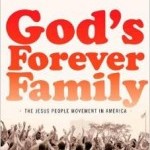I love to read. By God’s grace I am a pretty fast reader; I usually read a couple books each week. I find it helpful to summarize my thoughts on each book and I offer those thoughts in the hope that you will be encouraged to either read or pass over the given title.
 God’s Forever Family: The Jesus People Movement in America by Larry Eskridge. For two and a half years during high school I attended a Calvary Chapel in Sarasota, Florida. It was an utterly unique experience for me; casually dressed pastors preached through books of the Bible and men with guitars led corporate singing that consisted mostly of contemporary songs of praise. It was all very different from my traditional Southern Baptist upbringing. In time I learned how the Calvary Chapel movement descended from Chuck Smith and the Jesus People movement of the late 1960s and early 1970s. So when I saw, late last year, that evangelical historian Larry Eskridge published a book detailing the history and influence of the Jesus People movement I knew I had to read it. God’s Forever Family is book every pastor should consider reading if he wants to better understand the current landscape of evangelicalism.
God’s Forever Family: The Jesus People Movement in America by Larry Eskridge. For two and a half years during high school I attended a Calvary Chapel in Sarasota, Florida. It was an utterly unique experience for me; casually dressed pastors preached through books of the Bible and men with guitars led corporate singing that consisted mostly of contemporary songs of praise. It was all very different from my traditional Southern Baptist upbringing. In time I learned how the Calvary Chapel movement descended from Chuck Smith and the Jesus People movement of the late 1960s and early 1970s. So when I saw, late last year, that evangelical historian Larry Eskridge published a book detailing the history and influence of the Jesus People movement I knew I had to read it. God’s Forever Family is book every pastor should consider reading if he wants to better understand the current landscape of evangelicalism.
Eskridge’s able recounting of the movement’s movers and leaders is fascinating on a historical level. Stories of communes, coffee houses, rock bands, musicals, The Late Great Planet Earth, and hippie Christians make the book interesting even for casual readers. But the huge payoff comes in the final chapter where Eskridge evaluates “The Long-Term Impact of the Jesus People Movement.” He identifies three primary categories of the movement’s long-term impact and influence: music, popular youth culture, and church life. The primary takeaway for today’s pastor is how the Jesus People served as a catalyst for modern evangelicalism’s infatuation with “youth culture.” One reviewer wisely concludes, “When worship looks and sounds like youth group, the church is in danger of being led astray. The church needs youthful energy and boldness, but it also needs the experience and wisdom of older brothers and sisters who find themselves alienated from many evangelical congregations.” Amen. Any pastor would benefit greatly from Eskridge’s excellent work.
 Yawning at Tigers: You Can’t Tame God, So Stop Trying by Drew Dyck. After reading the first three chapters of Yawning at Tigers I was about ready to proclaim it as a modern version of Sproul’s The Holiness of God. Dyck is an excellent writer and his presentation of the Almighty is brilliant. Consider his comments on the scene at Sinai in Exodus:
Yawning at Tigers: You Can’t Tame God, So Stop Trying by Drew Dyck. After reading the first three chapters of Yawning at Tigers I was about ready to proclaim it as a modern version of Sproul’s The Holiness of God. Dyck is an excellent writer and his presentation of the Almighty is brilliant. Consider his comments on the scene at Sinai in Exodus:
[Exodus 19:16-19 is] a powerful scene, one that underscores God’s holiness and majesty. It’s also absolutely terrifying. After such an overwhelming encounter, I wonder if the idea of a mute idol seemed strangely attractive – for comfort if nothing else.
Here the contrast between God and an idol couldn’t be clearer. We’re told that after offering sacrifices to the golden calf, the Israelites ‘sat down to eat and drink and got up to indulge in revelry’ (Ex. 32:6). But when God descended on Mount Sinai ‘everyone in the camp trembled’ (Ex. 19:16). You don’t tremble before an idol.
Now that’s good. Yet, from chapter four on I found Dyck’s argumentation less compelling as he slides into more comfortable evangelical language about God’s holiness and love. Maybe my decreased enthusiasm is his tendency to over-illustrate; at least half the book is anecdotal or illustrative. Or maybe it’s how he can quote John Calvin in one sentence and John Eldridge in the next with equal favor. Don’t get me wrong, the book is solid. I bet my sense of disappoint largely stems from the incredibly high – and probably unrealistic – expectations those first three chapters created.
 Burning Hearts: Preaching to the Affections by Josh Moody and Robin Weekes. I love books like this one; short volumes that simply address one aspect of faithful proclamation. Moody and Weekes have a burden to see pastors effectively target their congregation’s heart – i.e. affections – in preaching. They define preaching as “the God-ordained means by which He meets with His people through His word and by His Spirit in such a way that His people’s eyes are opened to see Jesus and be captivated by Him” (25). For just over sixty-five pages the authors cover the what, why, and how of preaching to the affections; this is a quick and edifying read. The book’s usefulness is greatly multiplied in the final four chapters where the authors reproduce a sermon manuscript and then comment on its effectiveness in reaching the affections. Carson’s endorsement is a healthy summary, “For some, this will be a healthy reminder; for others, it will revolutionize their preaching.”
Burning Hearts: Preaching to the Affections by Josh Moody and Robin Weekes. I love books like this one; short volumes that simply address one aspect of faithful proclamation. Moody and Weekes have a burden to see pastors effectively target their congregation’s heart – i.e. affections – in preaching. They define preaching as “the God-ordained means by which He meets with His people through His word and by His Spirit in such a way that His people’s eyes are opened to see Jesus and be captivated by Him” (25). For just over sixty-five pages the authors cover the what, why, and how of preaching to the affections; this is a quick and edifying read. The book’s usefulness is greatly multiplied in the final four chapters where the authors reproduce a sermon manuscript and then comment on its effectiveness in reaching the affections. Carson’s endorsement is a healthy summary, “For some, this will be a healthy reminder; for others, it will revolutionize their preaching.”
Click here to find other entries in the Recent Reads series.
